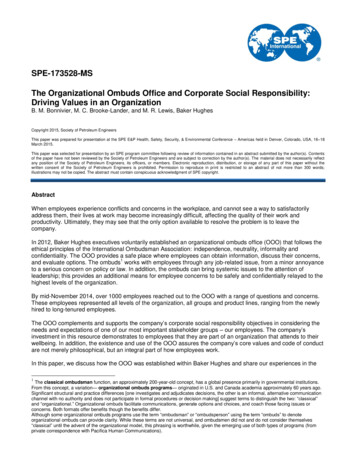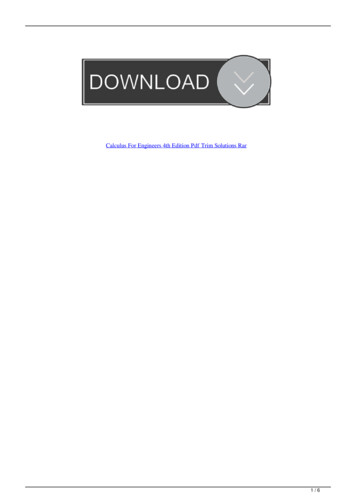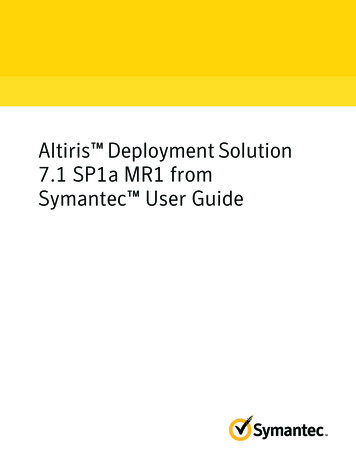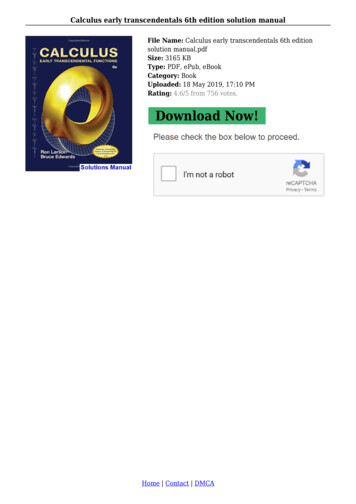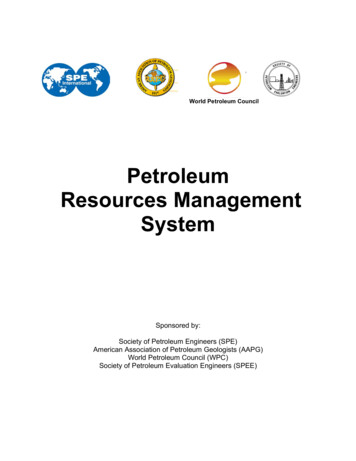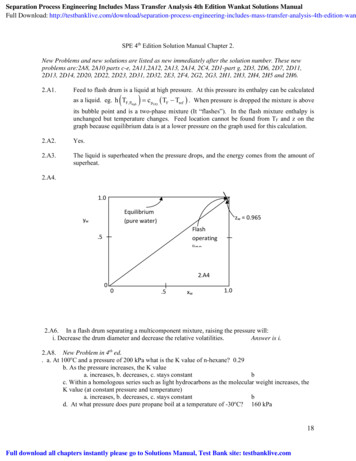
Transcription
Separation Process Engineering Includes Mass Transfer Analysis 4th Edition Wankat Solutions ManualFull Download: edition-wanSPE 4th Edition Solution Manual Chapter 2.New Problems and new solutions are listed as new immediately after the solution number. These newproblems are:2A8, 2A10 parts c-e, 2A11,2A12, 2A13, 2A14, 2C4, 2D1-part g, 2D3, 2D6, 2D7, 2D11,2D13, 2D14, 2D20, 2D22, 2D23, 2D31, 2D32, 2E3, 2F4, 2G2, 2G3, 2H1, 2H3, 2H4, 2H5 and 2H6.2.A1.Feed to flash drum is a liquid at high pressure. At this pressure its enthalpy can be calculated as a liquid. eg. h TF,Phigh c pLIQ TF Tref . When pressure is dropped the mixture is aboveits bubble point and is a two-phase mixture (It “flashes”). In the flash mixture enthalpy isunchanged but temperature changes. Feed location cannot be found from TF and z on thegraph because equilibrium data is at a lower pressure on the graph used for this calculation.2.A2.Yes.2.A3.The liquid is superheated when the pressure drops, and the energy comes from the amount ofsuperheat.2.A4.1.0Equilibrium(pure water)ywzw 0.965Flashoperatingline.52.A400.5xw1.02.A6. In a flash drum separating a multicomponent mixture, raising the pressure will:i. Decrease the drum diameter and decrease the relative volatilities.Answer is i.2.A8. New Problem in 4th ed. a. At 100oC and a pressure of 200 kPa what is the K value of n-hexane? 0.29b. As the pressure increases, the K valuea. increases, b. decreases, c. stays constantbc. Within a homologous series such as light hydrocarbons as the molecular weight increases, theK value (at constant pressure and temperature)a. increases, b. decreases, c. stays constantbd. At what pressure does pure propane boil at a temperature of -30oC? 160 kPa18Full download all chapters instantly please go to Solutions Manual, Test Bank site: testbanklive.com
2.A9.a.The answer is 3.5 to 3.6b. The answer is36ºCthc. This part is new in 4 ed. 102oCa. 0.22; b. No; c. From y-x plot for Methanol x 0.65,2.A10. Parts c, d, and e are new in 4th ed.yM 0.85; thus, yW 0.15. d. KM 0.579/0.2 2.895, KW (1 – 0.579)/(1 – 0.2) 0.52625.e. αM-W KM/KW 2.895/0.52625 5.501.2.A11. New problem in 4th edition. Because of the presence of air this is not a binary system. Also, it isnot at equilibrium.2.A12. New problem in 4th edition. The entire system design includes extensive variables and intensivevariables necessary to solve mass and energy balances. Gibbs phase rule refers only to theintensive variables needed to set equilibrium conditions.2A13. New problem in 4th edition. Although V is an extensive variable, V/F is an intensive variable andthus satisfies Gibbs phase rule.2A14. New problem in 4th edition. 1.0 kg/cm2 0.980665 bar 0.96784 atm.Source: Must be sure you don’t violate Gibbs phase rule for intensive variables in equilibrium.Examples:F, z, Tdrum , PdrumF, z, y, PdrumF, z, x, p drumF, z, y, p drumF, z, x, TdrumDrum dimensions, z, Fdrum , p drumDrum dimensions, z, y, p drumetc.2.B2.F, TF , z, pF, h F , z, pF, TF , z, yF, h F , z, yF, TF , z, xetc.F, TF , z, Tdrum , pdrumF, TF , y, pF, TF , y, TdrumF, TF , x, pF, TF , x, TdrumF, TF , y, xThis is essentially the same problem (disguised) as problem 2-D1c and e but with an existing(larger) drum and a higher flow rate.With y 0.58, x 0.20, and V/F 0.25 which corresponds to 2-D1c.lb mole, D .98 and L 2.95 ft from Problem 2-D1e .hrV and for constant V/F, V α F, we have D α F .If F 1000Since D αWith F 25,000:Fnew Fold 5, D new 5 D old 4.90, and L new 3 D new 14.7 .Existing drum is too small.19
Feedratedrumcanhandle:FαD2.2Fexisting D 4 exist 1000 .98 .98 2givesFexisting 16,660 lbmol/hAlternativesa) Do drums in parallel. Add a second drum which can handle remaining 8340 lbmol/h.b) Bypass with liquid mixingy .58,V .25 (16660) 415016,66025,0008340LTotalxSince x is not specified, use bypass. This produces less vapor.c) Look at Eq. (2-62), which becomesD V MWv 3K drum 3600 L v vBypass reduces Vc1)Kdrum is already 0.35. Perhaps small improvements can be made with a better demister Talk to the manufacturers.c2) ρv can be increased by increasing pressure. Thus operate at higher pressure. Note thiswill change the equilibrium data and raise temperature. Thus a complete newcalculation needs to be done.d) Try bypass with vapor mixing.e) Other alternatives are possible.zB V z A F K B 1 K A 1 2.C2.2.C5.a. Start withxi Fz iand let V F LL VK iFzizixi or x i L L L F L Ki 1 K iF F 20
Then yi K i x i From y xiK i ziL L 1 K iF F i 0 we obtain K i 1 ziL L 1 K iF F 02.C4. New Problem. Prove that the intersection of the operating and y x lines for binary flash distillationoccurs at the mole fraction of the feed.SOLUTION: y thereforeLF L F V L Fy z ,rearrange: y 1 z , or y z since V L F, the result is y z andVV V V V Vx y z(2-18)The intersection is at the feed composition. 2.C7.V/Ff00ziV1 K i 1 F.1-.09.2-.1 V 1 f F .3-.09From data in Example 2-2 obtain:.4.5-.06 -.007.6.07.7.16.8.3.9.491.0.7721
2.C8.Derivation of Eqs. (2-62) and (2-63). Overall and component mass balances are,F V L1 L 2 and Fz i L1x i,L1 L 2 x i,L2 Vyi Substituting in Eqs. (2-60b) and 2-60c)Fz i L1K i,L1 L2 x i,L 2 L 2 x i,L2 VK iV L 2 x i,L 2Solving,x i,L2 FziFzi L1K i,L2 L 2 VK i,V L2 L1K i,L1 L2 F V L1 VK i,V L2Dividing numerator and denominator by F and collecting terms.x i,liq 2 Sincey i K i,V L2 x i,L 2 , yi Stoichiometric equations,which becomesC i 1ziLV1 K i,L1 L2 1 1 K i,V L2 1 FFK i,V L2 ziLV1 K i,L1 L2 1 1 K i,V L2 1 FFCCCCi 1i 1i 1i 1 x i,L2 1 , yi 1 , thus, yi x i,L2 0 Ki,V L2 1 ziL1V 1K1K1 i,L1L2i,VL2 FF Since x i,liq1 K i,L1 L2 x i,liq2 , we have x i,liq1 CIn addition, x i,liq1 x i,liq 2 0 0K i,L1 L2 ziLV1 K i,L1 L2 1 1 K i,V L2 1 FF Ki,L1 L2 1 ziL1V 1 K i,L1 L2 1 F K i,V L2 1 F V 0.4 100 40 and L F V 60 kmol/hi 12.D1.a.(2-62)(2-63)Slope op. line L V 3 2, y x z 0.6See graph. y 0.77 and x 0.48b.V 0.4 1500 600 and L 900 . Rest same as part a.c. Plot x 0.2 on equil. Diagram and y x z 0.3. y int ercept zF V 1.2V F z 1.2 0.25 . From equil y 0.58 .d. Plot x 0.45 on equilibrium curve.LF V1 V F .8 4Slope VVV F.222
Plot operating line, y x z at z 0.51 . From mass balance F 37.5 kmol/h.e. Find Liquid Density.MW L x m MWm x w MWw .2 32.04 .8 18.01 20.82Then, VL x mMWwMWm 32.04 18.01 xw .2 .8 22.51 ml/mol m w .7914 1.00 L MW L VL 20.82 22.51 0.925 g/mlVapor Density: ρV p(MW)V,avg/RT (Need temperature of the drum)MW v y m MW m y w MW w .58 32.04 .42 18.01 26.15 g/molFind Temperature of the Drum T: From Table 3-3 find T wheny .58, x 20, T 81.7 C 354.7K ml atm 4 v 1 atm 26.15 g/mol 82.0575 354.7 K 8.98 10 g/ml molK Find Permissible velocity:u perm K drum v v , K drum exp A B nFlv C nFlv D nFlv E nFlv 2L 342-60 lb V V F 0.25 1000 250 lbmol/h, Wv V MW v 250 26.15 6537.5 lb / hlbmol F L F V 1000 250 750 lbmol/h, and WL L MW L 750 20.82 15, 615 lb/h,23
Flv WLWV V 15615 8.89 10 4 0.0744, and n Flv 2.598 L 6537.5 .925Then K drum .442, and u perm .442A cs V MW v u perm 3600 v .925 8.98 10 4 14.19 ft/s8.98 10 4250 26.15 454 g/lb 14.19 3600 8.98 10 4g/ml 28316.85 ml/ft3 2.28 ft 2 .D 4A cs 1.705 ft. Use 2 ft diameter. L ranges from 3 D 6 ft to 5 D 10 ftf.Note that this design is conservative if a demister is used.Plot T vs x from Table 3-3. When T 77 C, x 0.34, y 0.69. This problem is nowvery similar to 3-D1c. Can calculate V/F from mass balance, Fz Lx Vy. This isFz F V x Vy orV z y 0.4 0.34 0.17F y x 0.69 0.34g. Part g is a new problem. V 16.18 mol/h, L 33.82, y 0.892, x 0.756.2-D2.Work backwards. Starting with x2, find y2 0.62 from equilibrium. From equilibrium point plot op. line of slope L V 2 1 V F 2 V F 2 3 7.Figure). From equilibrium, y1 0.78 .For stage 1,Find z 2 0.51 x1 (seeV z1 x1 0.55 0.51 0.148 .F y1 x1 0.78 0.5124
2.D3.New Problem in 4th edition. Part a.x ethaneT oCy 04.110.86521.0-37.471.0b. See Figure. a. If 1 bubble of vapor product (V/F 0) vapor product, vapor yE 0.7492(highest) liquid xE zE 0.20 (highest) and T 18.26 oC. If 1 drop of liquid product (V/F 1) yE zE 0.20 (lowest), xE 0.035, T (by linear interpolation) 56.18 [(49.57 – 56.18)/(.297 .161)][.2 – 0.16] 54.2 oC (highest).c. See figure. Slope -L/V - (1 – V/F)/(V/F) - .6/.4 - 1.5. xE 0.12, yE 0.57, T 33.4oC.d. From equilibrium data yE 0.7492. For an F 1, L 1 – V, Ethane balance: .2L 1(.3) –0.7492 V. Solve 2 equations: V/F 0.1821. Can also find V/F from slope of operating line.e. If do linear interpolation on equilibrium data, x 0.05 (45-49.57)(0.1 -0.05)/(37.57 – 49.57) 0.069. From equilibrium plot y 0.375.Mass balance for basis F 1, L 1 – V and 0.069 L 0.18 – 0.375 V. Solve simultaneously, V/F 0.363.2.D4. New problem in 3rd edition. Highest temperature is dew pointSetz i yi . VF 0 K i yi x i . Want x i yi K i 1.0K ref TNew K ref TOld If pick C4 as reference: First guess yiK bu tan e 1.0,Ki T 41 C : K C3 3.1, K C6 0.125yi.2 .35 .45 4.0145 T too lowK i 3.1 1.0 .125Guess for reference: K C4 4.014, T 118 C : K C3 8.8, K C6 .9 yi.2.35.45 0.6099K i 8.8 4.0145 .9K C4,NEW 4.0145 .6099 2.45, T 85 : K C2 6.0, K C6 0.4425
yi .2 .35 .45 1.20K i 6 2.45 .44K C4,NEW 2.45 1.2 2.94, T 96 C : K C3 6.9, K C6 0.56yi.2.35 .45 0.804 Gives 84 CK i 6.9 2.94 .56Use 90.5º Avg last two T K C4 2.7, K C3 6.5, K C6 0.49.2 .35 .45 1.079 , T 87 88º C yi K i 6.5 2.7 .49 Note: hexane probably better choice as reference.2.D5.a)v 1 F2v2y zz1 0.55y12F1 1000y1 V 0.25 F 2x2x1 0.30b)p1,2 1 atmLFx1 z Plot 1st Op line.V1V1y1 0.66 z2y x z 0.55 to x1 0.3 on eq. curve (see graph)Slope L0.55 0.80.25 0.454545 L1 V1 F1 1000V1.55 0.55V 687.5 0.6875 F 1 1000V1 687.5 kmol/h F2L 0.75F 3 , y x z 2 0.66. Plot op lineV 0.25F0.66Fz0.66At x 0, y z V F 2.64. At y 0, x 2 z 0.880.25LL F 0.75c) Stage 2 V 0.25 ,F V F2 0.25 687.5 171.875 kmol/h F 2From graph y 2 0.82, x 2 0.63 . V2 26
2.D6.New problem in 4th ed. a.)The answer is VP 19.30 mm Hglog10 VP 6.8379 1310.62 1.2856100 136.05b.) The answer is K 0.01693. K VP19.30 Ptot 1.5 760 2.D7.New problem 4th ed.Part a. Drum 1: V1/F1 0.3, Slope op line -L/V -.7/.3 -7/3, y x z1 0.46. L1 F2 70.From graph x1 z2 0.395Drum 2: V1/F1 30/70, Slope op line -L/V -7/3, y x z2 0.395. L1 F2 – V2 40.From graph x2 0.263Part b. Single drum: V/F 0.6, Slope op line -L/V -40/60 -2/3, From graph x 0.295.More separation with 2 drums.27
2.D8. K i 1 zi 0 . Note that 2 atm 203 kPa. V 1 K i 1 V / F F Find K i from DePriester Chart: K1 73, K 2 4.1 K 3 .115Use Rachford-Rice eqn: f Converge on V F .076, V F V F 152 kmol/h, L F V 1848 kmol/h .ziwe obtain x1 .0077, x 2 .0809, x 3 .9113V1 K i 1 FFrom yi K i x i , we obtain y1 .5621, y 2 .3649, y3 .1048From x i 2.D9.Need hF to plot on diagram. Since pressure is high, feed remains a liquidh F CPL TF Tref , Tref 0 from chartCPL CPEtOH x EtOH CPw x wWhere x EtOH and x w are mole fractions. Convert weight to mole fractions.30 0.651 kmol46.0770 kg water 70 18.016 3.885 Total 4.536 kmolBasis: 100 kg mixture: 30 kg EtOH 28
1000.6512 22.046 Mole fracs: x E 0.1435, x w 0.8565 .4.5364.536at 100 C as an average C P value.Avg. MW Use C PLEtOHC PL 37.96 .1435 18.0 .8565 20.86Per kg this isCPLMWavg kcalkmol C20.86kcal 0.946 22.046kg Ch F 0.946 2000 189.2 kcal/kgwhich can now be plotted on the enthalpy composition diagram.Obtain Tdrum 88.2 C, x E 0.146, and y E 0.617 .F 1000 find L and V from F L V and Fz Lx VyForwhich gives V 326.9, and L 673.1Note: If use wt. fracs. CPL 23.99 & CPL MWavg 1.088 and h F 217.6 .z C4 35 Mole % n-butanex C6 0.7K C3 5, K C4 1.9, K C6 0.32.D.10 Solution 400 kPa, 70ºCFrom DePriester chartKnow y i K i x i ,xi All wrong.ziV1 K i 1 F, x i yi 1 z i29
K i 1 zi 0z C3 1 z C6 z C4 .65 z C6V1 K i 1 Fz C6z C6V V z C6 0.7 1 0.7 , z C6 0.7 0.49C6: 0.7 VVF F 1 K C6 1 1 0.7FF4 .65 z C6 0.9 .35 0.7z C6 0RR Eq:VVV1 41 0.91 0.7FFF2 equations & 2 unknowns. Substitute in for z C6 . Do in Spreadsheet. Use Goal – SeekR.R. to find V F. V/F 0.594 when R.R. equation 0.000881 .z C6 0.7 0.49V 0.7 (0.49)(0.594) 0.40894F2.D11. New Problem 4th ed. Obtain K ethylene 2.2, K propylene 0.56 from De Priester chart.KE yE/xE and KP yP/xP Since yp 1 – yE and xp 1 – xE , Kp (1 – yE)/(1 – xE).Thus, 2 eqs and 2 unknowns. Solve for yE and xE.xE (1 – Kp) / (KE – Kp) and yE KE xE KE (1 – Kp) / (KE – Kp)xE (1 – 0.56) / (2.2 – 0.56) 0.268 and yE KE xE (2.2)(0.268) 0.590Check: xp 1 – xE 1 – 0.268 0.732 and yp 1 – yE 1 – 0.590 0.410Kp yp/xp 0.410/ 0.732 0.56 OK2.D12.For problem 2.D1c, plot x 0.2 on equilibrium diagram with feed composition of 0.3.The resulting operating line has a y intercept z V / F 1.2 . Thus V F 0.25 (see figure inSolution to 2.D1) Vapor mole fraction is y 0.58.Find Liquid Density.MW L x m MWm x w MWw .2 32.04 .8 18.01 20.82Then, VL x mMWwMWm 32.04 18.01 xw .2 .8 22.51 ml/mol m w .7914 1.00 Find Vapor Density. v p MW L MW L VL 20.82 22.51 0.925 g/mlv(Need temperature of the drum)RTMW v y m MW m y w MW w .58 32.04 .42 18.01 26.15 g/molFind Temperature of the Drum T:FromTable2-7findTcorrespondingtoy .58, x 20, T 81.7 C 354.7K ml atm 4 v 1 atm 26.15 g/mol 82.0575 354.7 K 8.98 10 g/ml mol K Find Permissible velocity:u perm K drum L v v30
234K drum,horizontal 1.25 K drum,vertical exp A B nFlv C nFlv D nFlv E nFlv 1.25 Since V V F 0.25 1000 250 lbmol/h, Wv V MW v 250 26.15 lb lbmol 6537.5 lb / h L F V 1000 250 750 lbmol/h, and WL L MW L 750 20.82 15, 615 lb/h,Flv WLWVK drum,vertical V 15615 8.98 10 4 0.0744, and n Flv 2.598 L 6537.5 .925 0.442, and K drum,horiz 0.5525u perm 0.5525A cs V MW v u perm 3600 vA Cs 1.824 ft 2 , 0.925 8.98 10 4 17.74 ft/s8.98 10 4250 26.15 454 g/lbm 17.74 3600 8.98 10 4 g/ml 28316.85 ml/ft 3 A T A Cs 0.2 9.12 ft 2D 4A T 3.41 ft and L 13.6 ftWith L/D 4,2.D13. New Problem 4th ed.xbutane 1 – xE 0.912, ybutane 1 – yE 0.454. KE yE/xE 0.546/0.088 6.20, Kbutane yB/xB 0.454/0.912 0.498.Plot KE and Kbutane on DePriester chart. Draw straight line between them. Intersections with T and P axisgive Tdrum 15 oC, and pdrum 385 kPa from Figure 2-12.Use mass balances to find V/F: F L V and FzE LxE VyE. Substitute L F – V into ethane balanceand divide both sides by F. Obtain: z (1 – V/F)x y(V/F).Solve for V/F (z-x)/(y-x) (0.36 – 0.088)/(0.546 – 0.088) 0.594.Spreadsheet used as a check (using T 15 and p 385) gave V/F 0.593.2.D14.New Problem 4th ed. DePriester chart, Fig. 2-12: KC1 50, KC4 1.1, and KC5 0.37; z1 0.12, z4 0.48, z5 0.40Rachford-Rice equation: K C2 1 zC1 K iC4 1 z nC4 K nC4 1 z nC5VVV1 K nC4 1 1 K nC5 1 FFF5.880.0480.252 0Equation becomes:1 49(V / F ) 1 0.1(V / F ) 1 0.63(V / F )1 K C1 1 0Trials: V/F 0.4, Eq. -.005345; V/F 0.39, Eq. 0.004506; V/F 0.394, Eq. 0.000546, which isclose enough with DePriester chart.Liquid mole fractions:xC4 0.4618, xC5 0.5321, and xi 0.9998z C1.12x C1 1 K C1 1 (V / F) 1 49 .394 0.00591;Vapor mole fractions: yi Ki xi : yC1 50(0.00591) 0.2955, yC4 0.5080, yC5 0.1969, yi 1.0004.31
2.D15.This is an unusual way of stating problem. However, if we count specified variables we seethat problem is not over or under specified. Usually V/F would be the variable, but here itisn’t. We can still write R-R eqn. Will have three variables: zC2, ziC4, znC4. Need two othereqns: z iC4 z nC4 constant, and z C2 ziC4 z nC4 1.0Thus, solve three equations and three unknowns simultaneously.Do It. Rachford-Rice equation is, K C2 1 zC2V1 K C2 1 F K iC4 1 ziC4V1 K iC4 1 F K nC4 1 z nC2V1 K nC4 1 F 0Can solve for zC2 1 – ziC4 and ziC4 (.8) znC4. Thus zC2 1 – 1.8 znC4Substitute for ziC4 and zC2 into R-R eqn. K C2 1 .8 K iC4 1 K nC4 1 0z nC4 z nC4VV1 K C2 1 1 K iC4 1 1 K nC4 1 FFF K C2 1 V1 K C2 1 FThus,z nC4 K C2 1 .8 K iC4 1 K nC4 1 1.8 VVV1 K C2 1 1 K iC4 1 1 K nC4 1 FFF 1 1.8 z nC4 VCan now find K values and plug away. KC2 2.92, KiC4 .375, KnC4 .26.Solution is znC4 0.2957, ziC4 .8 (.2957) 0.2366, and zC2 0.46772.D16.z C1 0.5, z C4 0.1, z C5 0.15, z C6 0.25, K C1 50, K C4 .6, K C5 .17, K C6 0.051st guess. Can assume all C1 in vapor, 1/3 C4 in vapor, C5 & C6 in bottomV / F 1 .5 .1 / 3 .53 This first guess is not critical.R.R. eq.Eq. 3.33wherecalculate K i 1 zi 0 V f 1 K i 1 V F F 49 .5 .4 .1 .83 .15 .95 .25 0.157 1 49 .53 1 .4 .53 1 .83 .53 1 .95 .53 V V F 2 F 1f V F 1 zi K i 1 22V 1 K i 1 F V / F 1 0.53 and f V / F 1 0.157 . V / F 2 .53 0.157 2.92 0.584V .584 150 87.6 kmol/h and L 150 87.6 62.432
x C1 z C1.5 0.0168831 K C1 1 (V / F) 1 49 .584 yC1 K C1 x C1 50 0.016883 0.844Similar for other components.2-D17.a.V 0.4F 400,L 600 Slope L F 1.5Intercepts y x z 0.70. Plot line and find xA 0.65, yA 0.77 (see graph)b. V 2000, L 3000. Rest identical to part a.c. Lowest xA is horizontal op line (L 0). xA 0.12Highest yA is vertical op line (V 0). yA 0.52. See graphd.2.D18.V 600, L 400, -L/V -0.667.Find xA 0.40 on equilibrium curve. Plot op line & find intersection point withy x line. zA 0.52zh 1V xhziFrom x i , we obtain VFKh 11 K i 1 FGuess Tdrum , calculate K h , K b and K p , and then determine V F .Check: K1 1 zi1 K1 1 VF 0 ?Initial guess: Tdrum must be less than temperature to boil pure hexane33
Kh 1.0, T 94 C . Try 85 C as first guess (this is not very critical and the calculationwill tell us if there is a mistake). K h 0.8, K b 4.8, K p 11.7 .0.6 1V 0.850.6 1.471 . Not possible. Must have K h 0.706F0.8 10.85Try T 73 C where K h 0.6 . Then K b 3.8, K p 9.9 .0.6 1V .85 0.735F.6 1Check: K i 1 zi1 K i 1 VF 8.9 .1 2.8 .3 .4 .6 0.052761 8.9 .735 1 2.8 .735 1 .4 735 Converge on T 65.6 C and V F 0.57 .2.D19.90% recovery n-hexane means 0.9 Fz C6 L x C6 Substitute in L F V to obtain z C6 .9 1 V F x C6C8 balance: z C6 F Lx C6 VyC6 F V x C6 K C6 Vx C6z C6 1 V F x C6 x C6 K C6 V ForTwo equations and two unknowns. Remove x C6 and solvez C6 .93C6 Solve for V F. .9 z C6 KV F1 V FV.1 . Trial and error scheme.F .9K C6 .1Pick T, Calc K C6 , Calc V F, and Check f V F 0 ?If not K ref new TryK ref Told 1 d f T T 70 C. K C4 3.1, K C5 .93, K C6 .37 K refV.1 0.231 .F .9 .37 .1Rachford Rice equationf 2.1 .4 .08 .25 .63 .35 .287191 2.1 .231 1 .08 .231 1 .63 .231 .37 0.28745 use .28 1 0.28719 57 C. Then K C4 2.50, K C8 .67, and V F 0.293 .K ref Tnew Converge on TNew2.D20.New Problem 4th ed.34
K C2 4.8 K C5 0.153V z AzBV 0.550.45 0.5309,Soln to Binary R.R. eq.F K B 1 K A 1 F .153 1 4.8 1 z C20.55 0.1823, y C2 0.8749 , x C5 0.8177 , yC5 0.1251V 1 3.8 .5309 1 K C2 1 F2.D21.x C2a.)35
Need to convert F to kmol. Avg MW 0.55 30.07 0.45 72.15 49.17F 100, 000kg kmol 2033.7 kmol/h , V V F F 1079.7,hr 49.17 kgu Perm K drumb.)To findL F V 954.0 kmol/h L v vMW L 0.1823 30.07 0.8177 72.15 64.48MW V 0.8749 30.07 0.1251 72.15 35.33For liquid assume ideal mixture:V1 x C2 VC2,liq x C5 VC5,liq x C2VL 0.1823 L 30.07 0.54MW C2MW C5 x C5 C2,liq C5,liq 0.8177 72.15 103.797 ml/mol 0.63 MW L64.48 0.621 g/mlVL103.797atmg 35.33 MW v101.3 kPa mol 0.009814 g / mlFor vapor: ideal gas: v ml atmRT82.0575 303.16K mol KW vK drum : Use Eq. (2-60) with FlV LWV L700 kPaWL 997.7kmol 64.48 kg 6, 4331.7 kg/h , WV 881.5 35.33 31,143.4 kg/hhkmolFlV 64331.7 0.009814 0.259731,143.30.621K drum exp 1.877478 0.81458 n .2597 0.18707 n 0.2597 234 0.0145229 n 0.2597 0.0010149 n 0.2597 0.3372 0.621 0.009814 ft 1.0 mu Perm 0.3372 0.8111 m/s0.009814s 3.2808 ftkmol kg 1079.735.33 V MWVh kmol AC 1.392 m 2u Perm 3600 vm s g kg 106 cm3 0.8111 3600 0.009814 3 s h cm 1000g m3 D 4A C 1.33 m . Arbitrarily L D 4,L 5.32 m2.D22.New problem in 4th edition.a. V F – L 50 – 20 20 kmol/h. V/F 3/5, Slope operating line -L/V -20/30 - 2/3, zM 0.736
From graph, y 0.8, x 0.54.b. From graph of T vs. xM, Tdrum 72.3oC. (see graph).2.D23. New Problem 4th ed.Part a. Fnew (1500 kmol/h)(1.0 lbmol/(0.45359 kmol)) 3307 lb mol/h.V, WV, L, and WL are the values in Example 2-4 divided by 0.45359. The conversion factor divides out inFlv term. Thus, Flv, Kdrum, and uperm are the same as in Example 2-4. The Area increases because Vincreases: Area AreaExample 2-4/0.45359 16.047/0.45359 35.38 ft2.Diameter 4 Area / 6.71 feetProbably round this off to 7.0 feet and use a drum height of 28 feet.b.Fparallel 3307 – 1500 1807 lbmol/h.Flv, Kdrum, and uperm are the same as in Example 2-4. Vparallel (V/F) Fparallel 0.51 (1807) 921.6 kmol/h.37
Ac 16.047 V parallelVExample 2 4Then, Diameter 16.047 (921.6 / 765) 19.33 ft 24 Area / 4.96 feet , Use a 5.0 feet diameter and a length of 20 feet.2.D24. p 300 kPa At any T. K C3 y C3 x C3 , K’s are known. K C6 yC6 x C6 1 yC3 1 x C3 K C6 1 K C3 x C3 1 x C3 Substitute 1st equation into 2nd 1 x C3 K C6 1 K C3 x C3 , x C3 K C3 K C6 1 K C6K 1 K C6 1 K C6x & y C3Solve for xC3,C3C3K C3 K C6At 300 kPa pure propane K C3 1.0 boils at -14 CK C3 K C6(Fig. 2-10)At 300 kPa pure n-hexane K C6 1.0 boils at 110 CCheck:x C3 at -14 C1 1 K C6 1 K C6 1.0 1, y C3 1 K C61 K C6K 0 0 0y C3 C3 0,K C3K C3Pick intermediate temperatures, find K C3 & K C6 , calculate x C3 & yC3 .x C3 at 110 CTb.K C3K C6x C3y C3 K C3 x C31- 0.027 0.6840.99150ºC1.450.027 1.45 - 80.1030.659L V 0.6 0.4 1.5x C3 0.3 , V F 0.4,Operating line intersects y x 0.3,Slope 1.5LFF0.3aty x zx 0, y z 0.75VVV0.4SeeGraphFind yc3 0.63 and xC3 0.062Check with operating line: 0.63 1.5 .062 0.75 0.657 OK within accuracy of the graph.c.Drum T: K C3 y C3 x C3 0.63 0.062 10.2 , DePriester Chart T 109ºCd.y .8,x .16Slope L y .8 .6 0.45V x .16 .6 1 f .45fV/F f 1/1.45 0.6938
39
V 0.40 , Find pdrumF K A 1 z A K B 1 z B V 0 f F 1 K 1 V 1 K 1 V A BF F 20% Methane and 80% n-butane. Tdrum .50 ºC ,2.D25.Pick p drum 1500 kPa: K C4 13K nC4 0.4(Any pressure with K C1 1 and K C4 1.0 is OK)f1 Trial 112 .2 .6 .8 0.2178 1 12 .4 1 .6 .4 K C4 Pnew Pnew 1160Need lower pdrumK C4 Pold 0.4 0.511 with d 1.0 1 d f Pold 1 .2138 K C1 16.5 , f 2 15.5 .2 .489 .8 0.4305 .4863 0.0557691 15.5 .4 1 .489 .4 0.511 0.541 , Pnew 1100, K C1 17.41 0.05576916.4 .2 .459 .8 0.0159 , OK. Drum pressure 1100 kPaf3 1 16.4 .4 1 .459 .4 zi0.2 0.02645xi , x C1 V 116.4.4 1 K i 1 FyC1 K C1x C1 17.4 0.02645 0.4603K C4 Pnew b.)2.D26. a)Can solve for L and V from M.B.Find:b) Stage is equil.K C3 100 F V L45 Fz 0.8V 0.2162LL 59.95 and V 40.05y C30.20.8 .2552 3.700 , K C5 0.7838x C3 0.2162These K values are at same T, P. Find these 2 K values on DePriester chart.Draw straight line between them. Extend to Tdrum , p drum . Find 10ºC, 160 kPa.1064.8 2.2832 , VP 191.97 mmHg0 233.01b.) VP 3 760 2280 mmHg , log10 VP 6.853 1064.8 / T 233.01 2.D27. a.) VPC5 : log10 VP 6.853 Solve forT 71.65ºCPtot 191.97 mm Hg [at boiling for pure component Ptot VP ]1064.8d.) C5: log10 VP 6.853 2.8045 , VP 637.51 mm Hg30 233.01K C5 VPC5 Ptot 637.51 500 1.2750c.)40
C6: log10 VPC6 6.876 1171.17 2.2725 , VPC6 187.29 mm Hg30 224.41K C6 187.29 500 0.3746K A yA x Ae.)K B y B x B (1 y A ) / (1 x A )If K A & K B are known, two eqns. with 2 unknowns K A & y A x C5 Solve.1 K C61 0.3746 0.6946K C5 K C6 1.2750 0.3746yC5 K C5 x C5 1.2750 0.6946 0.8856f.) Overall, M.B., F L Vor 1 L VC5 : Fx F Lx Vy.75 0.6946 L 0.8856 VSolve for L & V: L 0.7099 & V 0.2901 molg.) Same as part f, except units are mol/min.2.D28.VhDFLFrom example 2-4, x H 0.19, Tdrum 378K, V F 0.51, y H 0.6, z H 0.40MWv 97.39 lbm/lbmole (Example 2-4)128316.85cm3lbm v 3.14 10 g mol 0.198 33454g lbmftft 3Example 2.4u perm K drum L v, VK horiz 1.25 K verticalFrom Example 2-4, K vertical 0.4433 , K horiz 1.25 0.4433 0.554112u perm 0.6960 0.00314 0.5541 0.00314 8.231 ft s [densities from Example 2-4]41
lbmol V V F 0.51 3000 1530 lbmol hh F lbmol lbm 1530 97.39 h lbmole A vap 25.68 ft 2ft s lbm 8.231 3600 0.1958 3 s h ft A total A vap / 0.2 128.4ft 3 , D min 4A total / 12.8ftVliq 5Vliq160, 068 55 85 8603.8ft 3 , h 83.51ft and h/D 6.5. D 243.41 60 min/ h2.D29. The stream tables in Aspen Plus include a line stating the fraction vapor in a given stream.Change the feed pressure until the feed stream is all liquid (fraction vapor 0). For the Peng-Robinsoncorrelation the appropriate pressure is 74 atm.The feed mole fractions are: methane 0.4569, propane 0.3087, n-butane 0.1441, i-butane 0.0661,and n-pentane 0.0242.b. At 74 atm, the Aspen Plus results are; L 10169.84 kg/h 201.636 kmol/h, V 4830.16 kg/h 228.098 kmol/h, and Tdrum -40.22 oC.The vapor mole fractions are: methane 0.8296, propane 0.1458, n-butane 0.0143, i-butane 0.0097,and n-pentane 0.0006.The liquid mole fractions are: methane 0.0353, propane 0.4930, n-butane 0.2910, i-butane 0.1298, and n-pentane 0.0509.c. Aspen Plus gives the liquid density 0.60786 g/cc, liquid avg MW 50.4367, vapor density 0.004578 g/cc 4.578 kg/m3, and vapor avg MW 21.17579 g/mol kg/kmol.The value of uperm (in ft/s) can be determined by combining Eqs. (2-64), (2-65) and (2-69)Flv (WL/WV)[ρV/ ρL]0.5 (10169.84/4830.16)[0.004578/0.60786]0.5 0.18272Resulting Kvertical 0.378887 , Khorizontal 0.473608, and uperm 5.436779 ft/s 1.657m/skgh 0.177 m 2mskg 1.657 3600 4.578 3 shm 4830.16A vapAto ta l A/ 0 .2 0 .8 8 4 m , D3vaph / D 6 5 V liq D2m in, t h u s V li q 6 D 24Ato ta l/ 1 .0 6 m/ 5 4 .2 3 mV liq ( V o l r a t e ) ( h o l d t i m e s u r g e t i m e ) (31 0 1 6 9 .8 4 k g / h6 0 7 .8 6 k g / m3)(9 / 6 0 st )s t 6 0 7 . 8 6 V liq / 1 0 1 6 9 . 8 4 9 / 6 0 0 . 1 0 3 h o u r s 6 . 1 8 m i n2.D30. a. From the equilibrium data if yA .40 mole fraction water, then xA 0.09 mole fraction water.Can find LA and VA by solving the two mass balances for stage A simultaneously.LA VA FA 100 and LA (.09) VA (.40) (100) (.20). The results are VA 35.48 and LA 64.52.42
b. In chamber B, since 40 % of the vapor is condensed, (V/F)B 0.6. The operating line for this flashchamber is,y -(L/V)x FB/V) zB where zB yA 0.4 and L/V .4FB/.6FB 2/3. This operating line goes throughthe point y x zB 0.4 with a slope of -2/3. This is shown on the graph. Obtain xB 0.18 & yB 0.54.LB (fraction condensed)(feed to B) 0.4(35.48) 14.19 kmol/h and VB FB – LB 21.29.c. From the equilibrium if xB 0.20, yB 0.57. Then solving the mass balances in the same way as forpart a with FB 35.48 and zB 0.4, LB 16.30 and VB 19.18. Because xB zA, recycling LB does notchange yB 0.57 or xA 0.09, but it changes the flow rates VB,new and LA,new. With recycle these can befound from the overall mass balances: F VB,new LA,new and FzA VB,
SPE 4th Edition Solution Manual Chapter 2. New Problems and new solutions are listed as new immediately after the solution number. These new problems are:2A8, 2A10 parts c-e, 2A11,2A12, 2A13, 2A14, 2C4, 2D1-part g, 2D3, 2D6, 2D7, 2D11, . Separation Process Engineering Includes Mass Transfer Analysis 4th Edition Wankat Solutions Manual.



